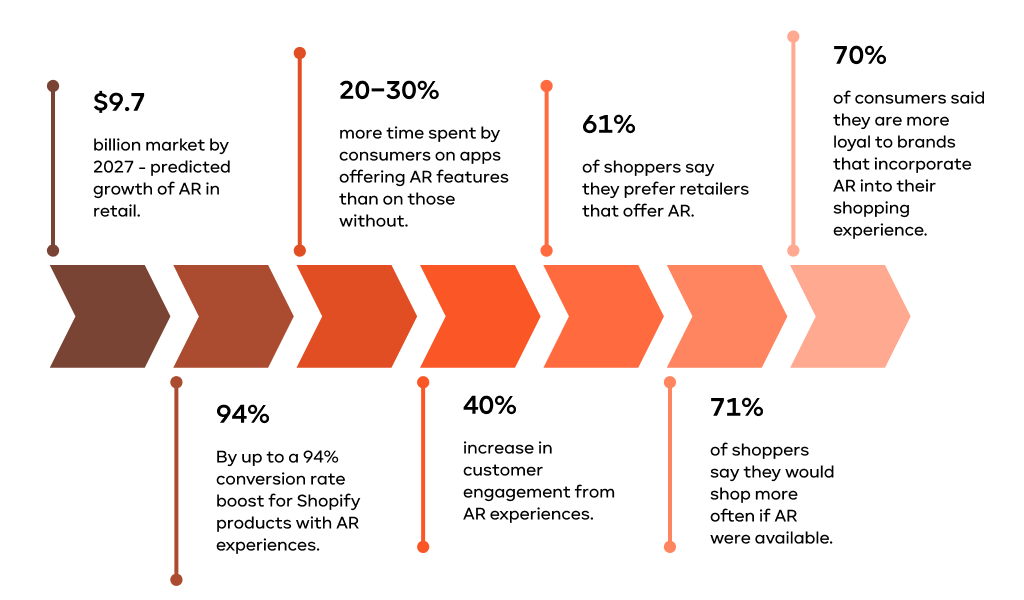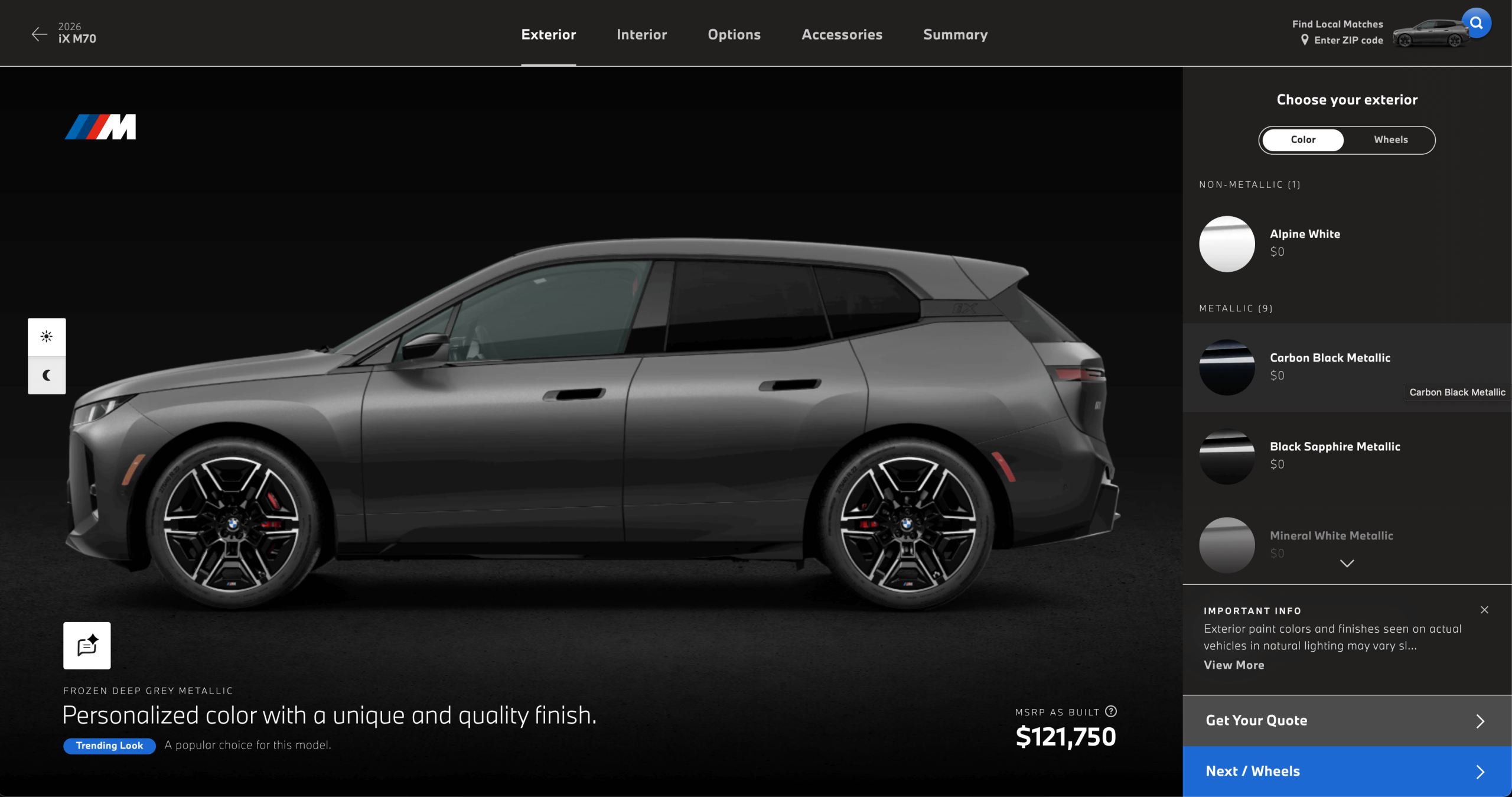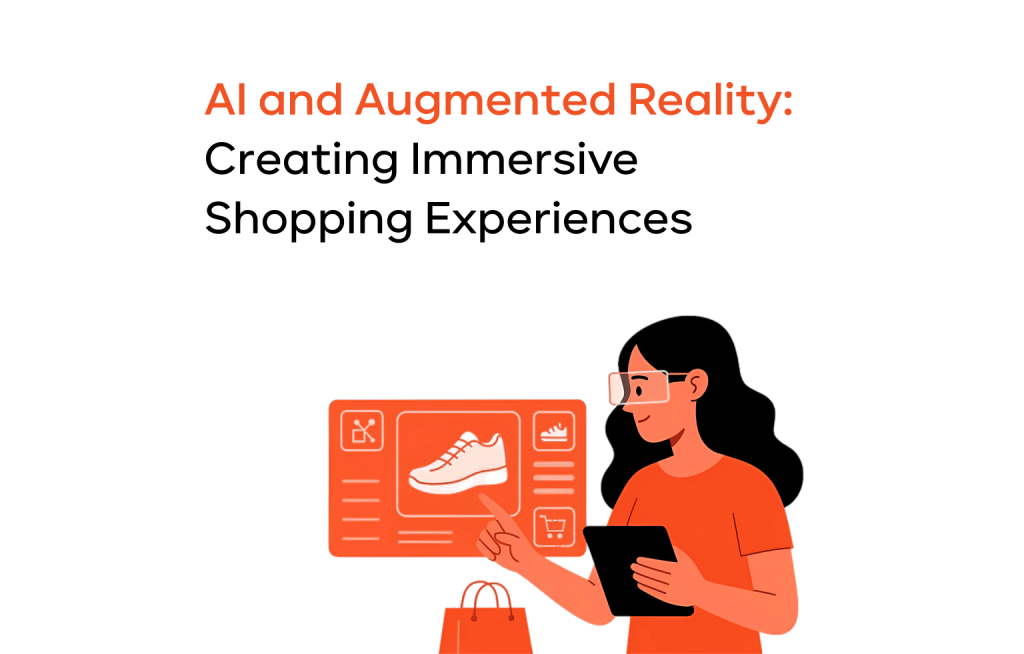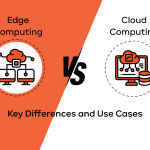Online retail is entering a new phase. Customers crave interactive, lifelike ways to explore products before they buy. The AI AR fusion has emerged as the perfect way to meet this need. It works behind the scenes to personalize suggestions and bring products into real-world settings. Shoppers see products in their homes, on their faces, or over their shoulders. All through a smartphone or tablet screen.
Let’s explore what this next wave looks like and how it addresses key pain points. We’ll also learn why it’s changing the game for modern e-commerce.
The future of retail is interactive and personalized
Today’s consumers expect more than basic images and bullet points. They want tangible proof that a product fits their style, space, or body. This expectation comes when AR AI solutions have matured enough to merge personalization with spatial visualization.
E-commerce is evolving beyond static product listings
Traditional product pages rely on text descriptions and flat images. While helpful, they struggle to convey real-world proportions or subtleties like texture and color in varying lighting conditions. This static approach often leads to guesswork. Shoppers may see a sofa that looks fine in a staged photo but doesn’t really fit their living room. That’s where experiences driven by AI augmented reality step in. Brands integrate 3D models, live camera feeds, and personalized data. This provides customers with the information they need to make more confident decisions.
Modern e-commerce reflects a broader desire for connected, immersive interfaces. These next-generation platforms cater to a shopper’s curiosity. They let users rotate, zoom in, and even view items in different color variations. Such an approach builds excitement and trust, especially when buyers can see how a product might look in their home or on their body. In this sector, the demand for interactive content has grown rapidly. It makes the adoption of AI AR more than a novelty – it’s becoming essential to stand out.
Rise of immersive experiences: try-before-you-buy, virtual fitting rooms, 3D product demos
Brands like Sephora, IKEA, and Warby Parker have launched tools that let shoppers “try” products virtually. Makeup brands allow users to see lipstick or eyeshadow colors on their faces. Furniture stores let you drop a sofa model into your living room. Eyewear retailers give you a live camera view of how frames fit your face. When combined with AR and AI, these features feel magical. Instead of wondering if a certain eyeshadow hue complements your skin tone, you can preview it in real time. Instead of guessing whether a couch fits your living room layout, you can see it to scale on your phone screen.
These 3D product demos go a step further by providing depth and detail. When you zoom in, you might see fabric texture or hardware finishes. This immersion reduces uncertainty, leading to fewer returns and more engaged shoppers.
AR and AI: merging personalization with visualization
At the heart of this shift is the partnership between two powerful technologies: augmented reality and artificial intelligence. AR projects 3D models into the user’s environment. AI tailors the experience to their unique taste. If you tend to buy minimalist designs, artificial intelligence augmented reality platforms can highlight items in that style right away. If your shopping history favors certain brands, you’ll see them first. This personalized approach streamlines the decision-making process and further deepens customer trust.
The synergy of AI and augmented reality also extends to recommending additional items that fit what you’re viewing. Imagine exploring a new coffee table in your living room via AR, then receiving a suggestion for matching chairs or rugs based on your previous purchases. This frictionless discovery transforms an ordinary retail moment into an engaging, curated journey.
Hook statistics
Here’s the deal: a rising wave of data supports the push toward AI AR. A survey by Think with Google showed that 66% of online shoppers are interested in AR assistance, confirming the strength of interactive tools in e-commerce.
Moreover, studies show that AI-driven personalization can boost customer satisfaction by up to 20%. These statistics underscore why forward-thinking businesses are pivoting to immersive retail strategies now rather than later.

The core challenges in modern online shopping
Many shoppers hesitate to buy online because they can’t feel or test a product. They’re worried about fit, color, size, or overall appeal. Let’s dive in and see how AI AR handles these uncertainties.
Product uncertainty: size, color, fit, feel
Buying apparel or home goods online is tricky. A size medium in one brand might be too small or too large in another. Colors can appear different under a camera flash or in a warehouse photo. A sofa that looked compact on a webpage might fill an entire living room in reality. This gap between visual guesswork and real-life details leads to hesitation. With augmented reality AI tools, customers instantly preview how a product aligns with their spaces, lighting conditions, and personal dimensions.
For example, imagine you’re ordering a new armchair. Standard product images don’t show how the chair’s shade of gray changes under warm vs. cool lighting. A real-time AI solution can detect your environment’s light level and adapt the color of the displayed 3D model. This dynamic approach gives you a sense of feel and scale that flat images can’t match.
High return rates and customer dissatisfaction
In fashion e-commerce, return rates can hover around 30%. That’s a significant strain on logistics and profit margins. Returns often involve shipping fees, restocking, and lost business when unhappy customers switch brands. By using AI augmented reality, retailers guide shoppers to make better decisions before clicking “add to cart.” This helps reduce the volume of returns tied to incorrect sizing or mismatched expectations.
Lack of emotional engagement or visual storytelling
Scrolling through static photos doesn’t convey brand personality or emotional resonance. Brands want to draw shoppers into a story: how they’ll feel wearing that jacket at a big event or how cozy a new couch could make family movie night.
Augmented reality vs artificial intelligence arguments often focus on which one is more critical for engagement. But in truth, they thrive together. AR ignites the emotional spark by placing items in the real world, while AI ensures each user sees a carefully selected range of products that match their style profile. Combining these elements drives a deeper sense of connection and brand loyalty.
AR helps bridge the sensory gap – AI makes it intelligent and relevant
Here’s why this matters: augmented reality helps overcome the inability to touch or feel a product by showing how it might look in the shopper’s home or on their body. Artificial intelligence uses data to refine which products appear and how they’re displayed. If a user has a modern aesthetic, the system might highlight sleek furniture. If they often buy muted tones, it may show color options that align with that preference. The result? A frictionless experience that boosts customer confidence and reduces guesswork.
How AI and AR work together in retail
Let’s dig deeper into how AI and AR share responsibilities. One handles the personalization logic, the other handles real-world visualization.
AI Personalization + AR Visualization
Two key steps come together at every stage: deciding what content the user sees (via AI) and showing that content in a realistic context (via AR).
AI chooses the best content
Picture a scenario where a shopper loves eco-friendly materials, typically shops at night, and has purchased items on sale before. An artificial intelligence augmented reality system might present sustainable products first, update deals in real time, and adapt the color of items based on previous choices. These applications of AI rely on data models that track and learn from user behavior over time.
AR displays it in the user context
After AI picks the right product, augmented reality projects a 3D model of it into a real-world environment using the shopper’s camera. If it’s a desk lamp, the user sees how the lamp’s light interacts with the rest of the room. It’s an instant shift from speculation to visualization. This goes beyond a flashy gimmick. It solves a real problem: bridging the gap between online browsing and in-store feeling.
Use of AI for:
Object recognition and real-world anchoring
To anchor virtual objects in a real scene, systems rely on AI algorithms that scan the environment through a mobile device. These algorithms measure surfaces and detect edges to place 3D models in stable positions. Whether you’re showing how a shoe looks on a foot or how a table fits in a corner, AR needs accurate anchoring so the item doesn’t float away or clip through walls. That’s where artificial intelligence is invaluable.
Face and body tracking
Face and body tracking are vital for makeup try-ons or clothing previews. Real-time mapping spots features like eyes, lips, or body contours. When a user shifts positions, the AR model responds. Lipstick colors remain aligned with the user’s lips, or a virtual shirt stays in place even if the user moves. By combining advanced facial recognition with augmented reality artificial intelligence, you get a fluid, realistic experience.
Style recommendations and personalization of visuals
In many projects, style engines analyze a customer’s browsing and purchase history to determine possible preferences. These suggestions don’t stop at recommending a single product. The system may also present complementary items: a matching jacket, the right shade of eyeshadow, or home decor pieces that fit a certain theme. By harnessing machine learning, retailers tailor the visuals in real time, guiding users toward options they are statistically more likely to love.
Lighting/environment adaptation using computer vision
The lighting in your home at noon differs from how it looks at dusk. If you’re shopping for a lamp, that difference matters. AI-driven computer vision can measure ambient light and adjust how a product appears. Shadows, highlights, and reflections all shift to mimic real-world physics. This level of realism helps customers develop trust in AR previews, as the item looks more authentic on their device screen.
Key use cases in e-commerce
From convenience to fun, here’s how AI AR expands the potential of online shopping.
Virtual try-ons
One of the most popular use cases is the virtual try-on for glasses, makeup, or clothing. A user simply points their phone camera at their face, and the screen displays how different styles look. This cuts guesswork and is especially helpful for hard-to-return products like prescription eyewear or custom-fitted outfits.
Place-it-in-your-room previews
Many customers worry whether furniture fits well in their homes. IKEA famously launched its AR app to address this. People use their smartphone camera to visualize a chair or table directly in their living space. They can walk around it, see it from multiple angles, and even test different finishes. This sense of personalization resonates deeply with shoppers. By connecting AR and AI (with user data), the system might suggest matching accessories for that new sofa or show the best layout for multiple items in the same room.
AI-powered 3D product configuration
Shoppers love customization. They want to pick colors, materials, or add-ons to create unique products. AR AI solutions let users tweak their selections in real time while seeing a 3D preview of each change. Imagine customizing your sneakers: you choose the sole, the stitching, and the color patterns. Each time you adjust an option, AI ensures that only viable combinations are shown, while AR displays the updated version from every angle. This makes personalization straightforward and engaging.

Interactive, gamified shopping experiences
In some brand apps, users unlock interactive features, such as virtual treasure hunts in store aisles. By scanning an item, they earn a discount or discover product details. This approach transforms routine shopping into a dynamic adventure. Snapchat has been a pioneer with AR filters that let people try on items in a playful, social environment. This not only boosts engagement but also fosters brand loyalty.
Visual search + AR: point, search, and preview
Ever see something in real life and want to know if it’s sold online? AR with visual search solves this. You take a photo of a product you like. The system identifies it (or a similar item) and allows you to preview it instantly in your own environment. This approach merges the offline and online worlds, giving customers quick access to a brand’s full inventory. If the store doesn’t have your size in stock, you can see how it looks on you and order it online, all within a single app.
_______________________________________________________________________
Ready to explore the potential of AR for your online store?
Contact us for a consultation and see how we can help you incorporate AWS-based solutions seamlessly into your retail platform.
_______________________________________________________________________
AWS tools for building AR and AI experiences
Behind these immersive retail platforms, a robust infrastructure ensures speedy performance and accurate results. Several AWS services make it easier to develop and deploy AI AR.
- Amazon Sumerian
Helps build technology solutions involving AR/VR scenes, avatars, and interactive virtual spaces. It offers templates and drag-and-drop components for 3D creation.
- Amazon Rekognition
Detects faces and objects in images. Useful for real-time object recognition, enabling AR placements that respond to the user’s environment.
- Amazon SageMaker
Trains custom machine learning models for tasks like clothing recognition, style recommendation, or environment analysis. Crucial for fine-tuning personalization engines.
- Amazon Polly
Generates lifelike voice outputs. Ideal for guided AR tours or voice assistants within apps.
- Amazon CloudFront + S3
Handles content delivery for 3D assets. By caching files on edge servers it reduces load times for users across the globe.
- AWS Lambda + API Gateway
Powers serverless backends, managing real-time logic and data flows for interactive features.
- ARKit, WebXR, Unity
Often integrated on the front end to deliver the virtual or 3D scenes. Work well in tandem with the AWS stack for seamless cross-platform applications.
Because these AWS services use robust security measures, developers can process data safely, even when dealing with sensitive camera or user information. For those seeking to build truly next-level experiences, AWS offers a scalable route to handle traffic spikes and advanced AI tasks.
IT-Magic’s approach to deploying immersive retail solutions
When it comes to creating memorable, high-performing AR-driven solutions, company leaders often worry about performance, security, and cost. IT-Magic addresses these concerns by combining best-in-class DevOps with proven frameworks.
- Performance:
By leveraging a content delivery network (CDN) and edge delivery, we reduce latency. 3D models load quickly, making sure customers don’t wait for assets to render. - CI/CD for AR:
We keep track of new versions of 3D models or AI updates with continuous integration pipelines. This process ensures smooth rollouts and minimal downtime. - DevOps for AI:
We set up inference pipelines so that the system can handle real-time predictions for personalization or object detection. Efficiently scaling compute resources keeps costs in check. - Security:
Secure APIs, data encryption, and compliance with data protection regulations remain top priorities.
At roughly one-third into our exploration of immersive retail, it’s clear that implementing AI and augmented reality can be challenging. That’s why our team at IT-Magic offers comprehensive solutions that blend these tools with secure, high-speed performance.
Business value of AI+AR in online retail
Below are some of the most impactful benefits businesses see when they integrate AI AR:
- Increase dwell time on product pages:
Customers spend longer interacting with dynamic 3D content and personalized recommendations.
- Improve conversion rates:
Shoppers gain more confidence in their choice, leading to higher click-to-buy ratios.
- Lower return rates via better pre-purchase confidence:
Visualizing items accurately helps customers select the right products from the start.
- Drive brand loyalty through innovative experiences:
Offering cutting-edge features sets a brand apart, encouraging repeat business.
- Leverage data from AR sessions to personalize future offerings:
Every interaction offers insights into user preferences, fueling more refined AI models.
Challenges and how to solve them
Although AI AR is exciting, real-world implementations come with hurdles. Here are some common issues and the fixes that help ensure success:
- Device compatibility
- Problem: Not all customers have the latest phones or tablets.
- Solution: Provide fallback modes or progressive loading so users on older devices can still view simplified 2D or interactive previews.
- 3D model size
- Problem: High-resolution 3D files can slow load times.
- Solution: Use mesh compression and asset streaming. Deliver lower-detail models first, then add details if bandwidth allows.
- Data privacy
- Problem: Storing images or user patterns can risk personal data leaks.
- Solution: Encrypt data, limit storage durations, and comply with GDPR or other relevant regulations.
- UX/UI
- Problem: Inconsistent user experiences harm brand perception.
- Solution: Keep design elements consistent across web, mobile, and in-store platforms. Provide intuitive icons and instructions for AR interactions.
- Infrastructure cost if not optimized
- Problem: Running advanced AI models and large AR assets can be expensive.
- Solution: Use serverless computing, pay-as-you-go pricing, caching, and AI model optimizations to manage usage spikes economically.
At around two-thirds of the way through, it’s worth noting that facing these challenges head-on with the right strategies can significantly reduce friction for both customers and your tech team.
Real-time metrics that matter
To ensure any AI + AR project succeeds, you’ll want to measure specific KPIs:
- Engagement duration: Track how long customers use AR features, an indicator of user interest.
- Conversion lift from AR vs non-AR pages: Compare typical product pages to those with immersive elements.
- Return rate reduction: See if your overall return volume drops after implementing AR.
- Satisfaction scores: Gather feedback or star ratings from users who tried AR-enabled shopping.
- Load time of assets (LCP, TTI): Monitor these web metrics to maintain smooth performance.
Regularly analyzing these metrics helps refine experiences. For instance, if the time-to-interactive (TTI) is too high, you can optimize content delivery further.
Final thoughts: The intelligent storefront of the future
Artificial intelligence and augmented reality solutions aren’t just futuristic experiments. They’re here, proving their worth across e-commerce. Leading brands have already jumped on board, recognizing that these technologies reduce uncertainty, raise excitement, and drive growth. By blending personal recommendations with in-world previews, you create a shopping journey that captivates and converts.
For teams nervous about complex integrations or inflated costs, the answer lies in adopting best practices. Leveraging DevOps, serverless infrastructure, and managed services can keep budgets in check while maintaining reliability. Platforms like AWS make it simpler to scale up or down, focusing on the user experience. Meanwhile, thoughtful security measures protect sensitive data.
AI AR doesn’t require an in-house fleet of DevOps engineers and solution architects, especially when you partner with a trusted company that knows how to integrate AWS tools for cost-effective, high-performance outcomes.
Contact us to explore how immersive tech can upgrade your product pages and boost customer retention
Ready for an upgrade? We’d love to guide you. Get a detailed consultation or a live demo of how we deploy Amazon Sumerian, SageMaker, and more to create engaging, security-first experiences.
FAQ
How accurate are AR previews when placing items in a real room?
Many modern apps measure depth and surfaces to ensure that the 3D model reflects the correct size and position. Calibration can involve reading sensor data, such as the phone’s camera feed and motion tracking, to place the object convincingly. For the best accuracy, developers often rely on advanced frameworks like ARKit or WebXR, which also adapt to environment details like furniture and wall edges.
How secure is customer data when using AI and AR?
Privacy remains a top concern whenever you capture video or use personal preferences. With AWS, data is encrypted at rest and in transit. Access controls limit who can view or modify sensitive information. Developers can also anonymize usage data, so any insights gleaned are purely behavioral, never personal.
How secure is customer data when using AI and AR?
Static solutions show the same images for all. Intelligent approaches leverage personal data to tailor product recommendations in real time. With encryption standards like AWS KMS, the flow of personal data stays protected. Strict authorization policies ensure that only the right processes can access that data, making it both personalized and secure.




